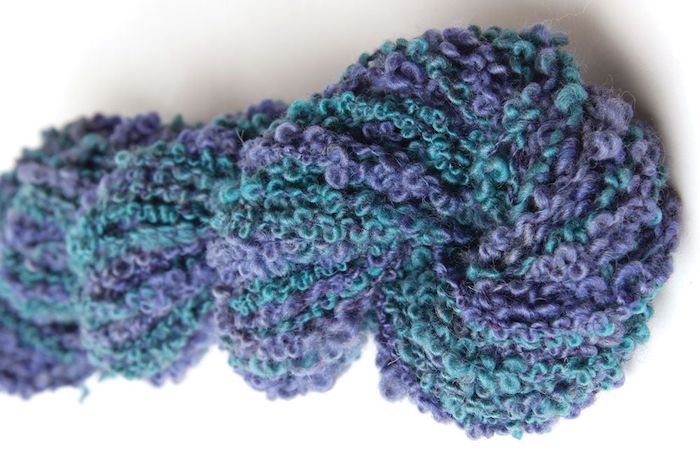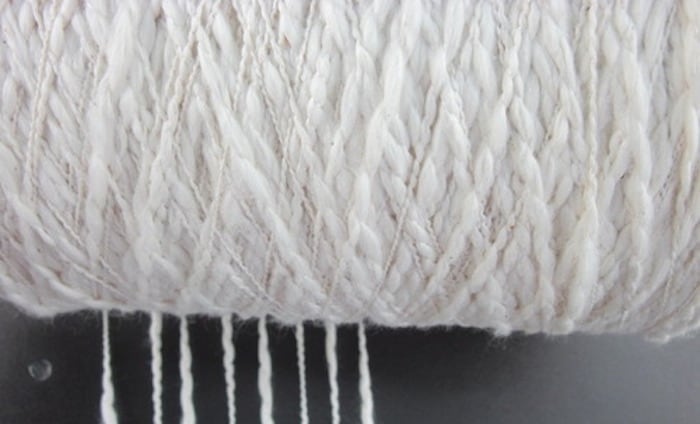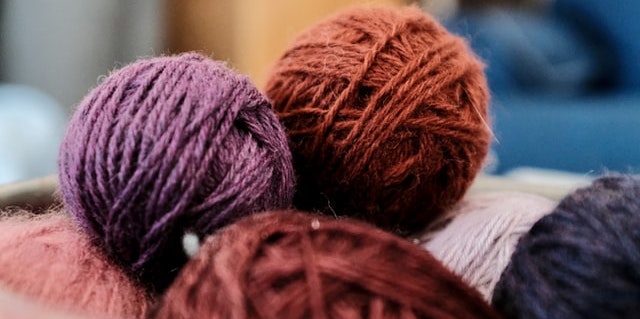Yarn is a continuous length of interlocking fibers and is used to make fabrics, as well as crocheting, knitting, embroidery, and ropemaking. Yarn is a secondary raw material used in the production of textile goods.
Compared to fiber, the yarn structure has a more significant impact on the internal quality and appearance of the textile. Fineness and twist are two important properties of yarns that should choose appropriately due to the yarn application.
Fineness relates to the yarn’s thickness, which significantly impacts the fabric’s appearance, handle, weight, and mechanical qualities. Twisting is a requirement for the formation of yarns from short fibers. Twisting also affects the fabric structure and qualities by changing the yarn density, strength, and gloss. Yarns can be classified into different categories considering their material, spinning process, application, etc.
Spun and Filament Yarns
Two main categories of yarns are spun and filament yarn. The appearance, structure, and performance of these two types of yarns are vastly different. Spun yarn is formed from short, discrete fibers and includes materials such as cotton and wool. In contrast, filament yarn is made from long, continuous filaments and contains materials such as polypropylene and nylon.
Spun yarn is made by twisting together fibers or filaments to form a continuous assembly of overlapping fibers. Spun yarns can either contain a single type of fiber or a combination of different kinds of fibers. All-natural fibers except silk are spun fibers. Spun yarns are hairier, softer, and less glossy than filament yarn and are preferred for clothing. They also pill more easily than filament yarns.
Filament yarn is made up of long, continuous filaments that have been twisted or clustered together. Filament yarns can be natural or synthetic. They offer a high level of uniformity as well as a high level of strength. Filament yarns are silky, glossy, and do not pill or lint easily.
Single-ply and Multi-ply Yarns
Spun yarns can be classified into two categories, including single-ply and multi-ply yarns. The spun or staple yarn having only one ply is called single-ply yarn. Multi-ply yarn is a spun or staple yarn made up of more than one ply twisted together. Plied yarns are more durable and less susceptible to pilling.
Monofilament and multi-filament are the two forms of filament yarns. Monofilament yarns have only one filament fiber. Multi-filament yarn is made up of two or more filament strands that have been plied or twisted together. Multi-filament yarns are substantially more flexible than monofilament yarns and have a larger covering power at the same linear density.
The structural integrity of the strand is preserved by giving the filaments a slight twist. A cold air jet (alternative to twist) can entangle the component filaments in some cases, resulting in intermingled or commingled yarn. Comingled yarns have more than one filament type, whereas intermingled yarns have only one filament type.
Flat and Textured Yarns
The two main types of multifilament yarns are flat and textured yarns. Multifilament yarns with a low twist count are known as flat yarns. Low bulk, low covering power, and low stretch at tiny applied loads characterize these yarns, which are intrinsically smooth and lustrous.
These yarns have limited applications. Texturizing is important for apparel applications as it improves opacity, decreases slipperiness, and increases warmth (by trapping air). Loops, crimps, and coils are formed in the filaments to give them texture.
Zero-twist to High twist yarn
Wrapping soluble filament with untwisted staple fibers produces zero-twist yarn. Wrapping is done with hot water-soluble filaments, which are dissolved in hot water after weaving. Because spun yarn seems to be twistless, it is referred to as zero twist yarn. Spun yarn can be categorized into three kinds based on the degree of twist: Low twist yarn, Normal twist yarn, and High twist yarn.
Low twist yarn has a lower degree of twist than ordinary yarn. It has bulkiness and a soft feel. It has a lower tensile strength and appears to be coarser than regular twist yarn. Fabrics manufactured with this yarn have poor pilling qualities.
According to spinning norms and regulations, Normal twist yarn has a regular twist. High twist yarn has a higher degree of twist than regular yarn, making it have a rough feel. It has a higher tensile strength than standard twist yarn.
Ring and Open-end Yarns
Spun yarn can be divided into two classes based on the spinning process, Ring Frame yarn and Open-end yarn. Ring spinning is a technique for producing yarn from fibers such as cotton, flax, or wool. Ring-spun yarns have a structure that offers them visual, tactile, aesthetic, and elastic fabric qualities suited for a wide range of applications.
Shirts, trousers, nightwear, blouses, overalls, jackets, skirts, sheeting, curtaining, and other industrial textiles use ring-spun yarns. The yarn can be carded or combed, with the latter having less hairiness, more excellent uniformity, and greater strength due to longer and more parallel fibers.
The way ring-spun yarns and open-end yarns are made is the primary distinction. The former creates yarn by twisting a continuous ribbon-like string of cohesive fibers given by the front rollers. The latter creates yarn directly from individual fibers by twist forces collecting them from the inside surface of a rotor. A ring yarn is formed from the outside in, whereas an open-end yarn is formed from the inside out. Thus, the structure of open-end yarn differs significantly from that of ring-spun yarn.
The fibers in an open-end yarn strand are not as parallel as those in ring-spun yarn. Even though open-end spinning uses larger twist multiples, open-end yarns are often weaker than ring yarns. This is related to the fact that open-end yarns have less fiber parallelism. This lack of direction, on the other hand, tends to promote elongation at break. Using the same fiber input into both, the following are important properties of the open-end yarn compared to ring-spun yarn: weaker, higher elongation at break, more uniform, better abrasion resistance, less hairy, less shedding, bulkier, and larger yarn packages with no knots.
Novelty Yarns
Novelty yarns are manufactured with uncommon features, structures, or fiber compositions. Complex yarns are another term for novelty yarns. Complex yarns are irregular yarns with curls, loops, twists, and even various colored sections along their length. The yarns’ appearance is used to create fascinating fabric effects. Novelty yarns come in a wide range of colors, textures, and fibers. In the following, some of the most popular novelty yarns are mentioned.
Bouclé Yarn
Bouclé yarns, also known as looped yarns, are made by looping an effect yarn loosely around a base yarn. They are generally comprised of three plies, or strands, wrapped around each other and can be made of any fiber. One of the three plies is spun more loosely than the other two to create the texture.

Chenille Yarn
Chenille yarns, which resemble pipe cleaners in appearance, have a soft, fuzzy surface that can be made in various methods. Typically, a fabric is created first, then cut into small strips that resemble yarn. The raw edges become extremely fuzzy when the fabric is cut, giving the fabric a chenille appearance.
The fuzzy appearance of other chenilles is achieved by clipping a loosely connected effect fiber. Other chenilles are made by gluing or adding fibers to the yarn.
Slub Yarn
Slub yarn is defined as a yarn with fixed-size thick spots at regular intervals of distance. It could be a single-ply yarn or a multi-ply yarn. Slubs or thick spots in the yarn are made by altering the tightness of the yarn’s twist at different intervals.

Flock/Flake Yarn
Flock/flake yarn is a yarn with tiny tufts of various colored fibers inserted at regular intervals. These tufts may be easily pulled out. Single yarns are commonly used in flock and flake yarns. The majority of flake yarn applications are in end-use fabrics that require a fancy effect texture.
Nub, Knot, or Spot Yarn
Nub, knot, or spot yarn is a plied yarn in which the effect yarn is twisted around the base yarn to create a thicker area or a bump. There are noticeable bunches of one or more component yarns at regular or irregular intervals in this pattern. This is done on a particular machine that allows the base yarn to be held almost stationary while the effect yarn is wrapped around it numerous times to create an expanded section with brilliantly colored fibers added at the enlarged spot.





















Great! Such detailed information on the types of yarn available in textile industry. The explanation behind the process of making these yarns is commendable. It should not be forgotten that the spinning process involved in making the yarn is also important as it defines the quality of yarn produced.